All About Table Saws
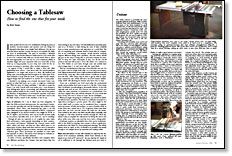
A tablesaw is the power-tool centerpiece of many woodshops. These tools can represent a substantial investment, and a full-size model occupies a good chunk of floor space. But a tablesaw is capable of a wide range of jobs — from ripping solid lumber and sheets of plywood to precise crosscuts and joinery. Few tools are as versatile or used as often.
What Counts:
• Saw type
• Power of motor
• Size and flatness of work surface
• Fence design and operation
• Rip capacity
• Ease of dust collection
• Portability of tool
Four saw types
Although they share the same fundamental design, tablesaws are roughly divided into four categories: portable saws, contractor saws, hybrid models, and full-size cabinet saws. Choosing one involves inevitable tradeoffs: As size and power increase, tablesaws become less portable and more costly. A good first step before investing in one is to think about how the saw will be used, whether it will have to be moved with any frequency and how much shop space can be devoted to it. Key features to compare are table-top size and rip capacity, motor size and fence design.
Portable saws
Portable tablesaws, weighing 75 lb. or less and available for about $200 to $500, can be used on a bench top, a pair of sawhorses or a portable stand. Because they are made from lightweight materials, including alloys and aluminum, these saws are very easy to move around. But their 115-volt motors won’t handle heavy loads easily and their relatively small mass may mean noticeable vibration. Some models have limited rip capacities.
Contractor saws
Contractor saws are heavier, up to 250 lb., typically with 1-1/2-horsepower motors that can run on either 115-volt or 230-volt current. Costs range from about $600 to about $1,000. These saws often have larger cast iron tops, and possibly cast wings, which help to dampen vibration. Fences are often sturdier. These saws typically rest on open frames, which keeps the weight and cost down but also complicates dust collection.
Hybrid saws
 |
Hybrid tablesaws are a relatively new tool category that represent a middle ground between the open-framed contractors saws and larger cabinet saws. Motors are slightly more powerful than those on contractor’s saws and are housed inside the cabinets, making dust collection easier. They cost up to $1,200 and weight as much as 375 lb.
Cabinet saws
Cabinets saws, weighing 400 lb. or more, have fully-enclosed cabinets, 3-hp or 5-hp motors that use 230-volt current and multiple drive belts. Prices start at about $1,200. Cabinet saws, especially when equipped with out-feed tables, are not really designed to be moved around the shop, but their weight means less vibration and very accurate cuts. Motors will power blades through thick hardwood; miter gauges and fences should be sturdy and accurate.
Fine Woodworking Recommended Products
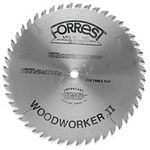
Forrest Woodworker II Blade
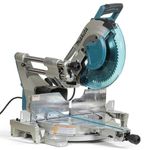
Makita LS1219L Miter Saw
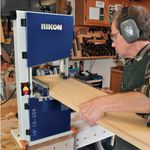
Rikon 10-3061 10-in. Deluxe Bandsaw
The saw has two speeds: 3,280 sfpm (surface feet per minute) for wood and 1,515 sfpm for soft metals and some plastics.
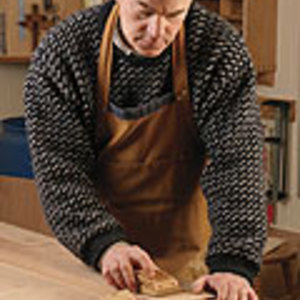






















Log in or create an account to post a comment.
Sign up Log in